This article needs additional citations for verification .(July 2023) |
Ragnemod (also known as Ragnemodus) was a 6th-century bishop of the archdiocese of Paris.
Contents
He is recorded briefly in Gregory of Tours' writings.
This article needs additional citations for verification .(July 2023) |
Ragnemod (also known as Ragnemodus) was a 6th-century bishop of the archdiocese of Paris.
He is recorded briefly in Gregory of Tours' writings.
In Gregory's Miracles of Martin, prior to becoming bishop of Paris, Ragnemod was afflicted with dysentery and he was cured with dust from the tomb of Martin of Tours. [1]
He succeeded Germain of Paris as bishop upon the latter's death in 576.
According to Gregory, Merovech, the son of King Chilperic I was forced to become a monk by his father after he had tried to marry his aunt. However, Merovech escaped and fled to Tours where he took refuge in the church of Saint Martin. Ragnemod was present at the time with Gregory, who was bishop of Tours, and Merovech asked them to give him communion, but they refused. Merovech threatened to kill some of their people if he was not given communion, and Gregory then decided to give him communion to avoid bloodshed.
Ragnemod was one of the bishops present at the church synod that judged and condemend Prætextatus, bishop of Rouen, in 577.
According to Gregory, some killings occurred within the church of Saint Denis in Paris as a result of a dispute about a woman who was alleged to be adulteress. As a result of this, the church was placed under interdict. Those who shed blood in the church went to Bishop Ragnemod and made atonement for their conduct, and he received them back into communion.
Ragnemod baptized Chilperic's son Theuderic during the Easter celebration of 583 or 584.
Gregory recounted a story of an imposter who claimed to possess Vincent of Saragossa and one of the martyr saints named Felix. This imposter first went to Tours before he went to Paris. During the days leading up to the feast of the ascension, this imposter joined Bishop Ragnemod's procession through the city. The bishop discovered the imposter and had him locked up for questioning. He found a number of items in his possession that he believed to be used in sorcery and had them cast into the river. Ragnemod then ordered the man to be driven out of Paris. [2]
Ragnemod was nicknamed 'Rucco' by Venantius Fortunatus.
He died in Paris in the year 591. [3]

Canonization is the declaration of a deceased person as an officially recognized saint, specifically, the official act of a Christian communion declaring a person worthy of public veneration and entering their name in the canon catalogue of saints, or authorized list of that communion's recognized saints.

Martin of Tours, also known as Martin the Merciful, was the third bishop of Tours. He has become one of the most familiar and recognizable Christian saints in France, heralded as the patron saint of the Third Republic, and is patron saint of many communities and organizations across Europe. A native of Pannonia, he converted to Christianity at a young age. He served in the Roman cavalry in Gaul, but left military service at some point prior to 361, when he became a disciple of Hilary of Poitiers, establishing the monastery at Ligugé. He was consecrated as Bishop of Caesarodunum (Tours) in 371. As bishop, he was active in the suppression of the remnants of Gallo-Roman religion, but he opposed the violent persecution of the Priscillianist sect of ascetics.

Gregory of Tours was a Gallo-Roman historian and Bishop of Tours during the Merovingian period and is known as the "father of French history." He was a prelate in the Merovingian kingdom, encompassing Gaul's historic region.

Clotilde, also known as Clothilde, Clotilda, Clotild, Rotilde etc., was a Queen of the Franks. She was supposedly descended from the Gothic king Athanaric and became the second wife of the Frankish king Clovis I in 493. The Merovingian dynasty to which her husband belonged ruled Frankish kingdoms for over 200 years (450–758).

Chlothar II, sometime called "the Young", was king of the Franks, ruling uled Neustria (584-629), Burgundy (613-629) and Austrasia (613-623).
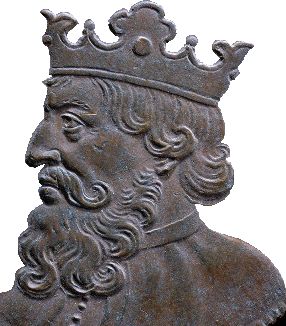
Chilperic I was the king of Neustria from 561 to his death. He was one of the sons of the Frankish king Clotaire I and Queen Aregund.

Martial, called "the Apostle of the Gauls" or "the Apostle of Aquitaine", was the first bishop of Limoges. His feast day is 30 June.
Fredegund or Fredegunda was the queen consort of Chilperic I, the Merovingian Frankish king of Soissons. Fredegund served as regent during the minority of her son Chlothar II from 584 until 597.
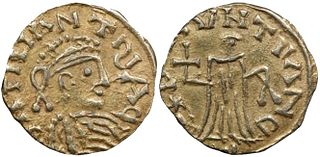
Saint Gontrand, also called Gontran, Gontram, Guntram, Gunthram, Gunthchramn, and Guntramnus, was the king of the Kingdom of Orléans from AD 561 to AD 592. He was the third-eldest and second-eldest-surviving son of Chlothar I and Ingunda. On his father's death in 561, he became king of a fourth of the Kingdom of the Franks, and made his capital at Orléans. The name "Gontrand" denotes "War Raven".

Germain was the bishop of Paris and is venerated as a saint in both the Catholic Church and the Eastern Orthodox Church. According to an early biography, he was known as Germain d'Autun, rendered in modern times as the "Father of the Poor".

Venantius Honorius Clementianus Fortunatus, known as Saint Venantius Fortunatus, was a Latin poet and hymnographer in the Merovingian Court, and a bishop of the Early Church who has been venerated since the Middle Ages.
Brunhilda was queen consort of Austrasia, part of Francia, by marriage to the Merovingian king Sigebert I of Austrasia, and regent for her son, grandson and great-grandson.
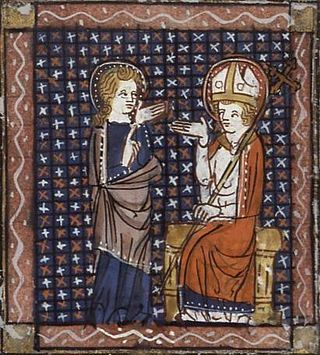
Brice of Tours was a 5th-century Frankish bishop, the fourth Bishop of Tours, succeeding Martin of Tours in 397.
Basina, was a Frankish princess, the daughter and youngest child of Chilperic I, King of Soissons, and his first wife, Audovera. After surviving the assassination of her immediate family, she became a nun. She later helped to lead a rebellion by a group of the nuns, which became a scandal throughout the region. This event was chronicled by the bishop and saint, Gregory of Tours, who was one of the bishops chosen to settle the matter.
Saint Prætextatus, also spelled Praetextatus, Pretextat(us), and known as Saint Prix, was the bishop of Rouen from 549 until his assassination in 586. He appears as a prominent character in Gregory of Tours’ Historia Francorum. This is the principal source from which information on his life can be drawn. He features in many of its most notable passages, including those pertaining to his trial in Paris and his rivalry with the Merovingian Queen Fredegund. The events of his life, as portrayed by Gregory of Tours, have been important in the development of modern understandings of various facets of Merovingian society, such as law, the rivalry between kings and bishops, church councils, and the power of queens.

Saint Perpetuus was the sixth Bishop of Tours, serving from 460 to 490.
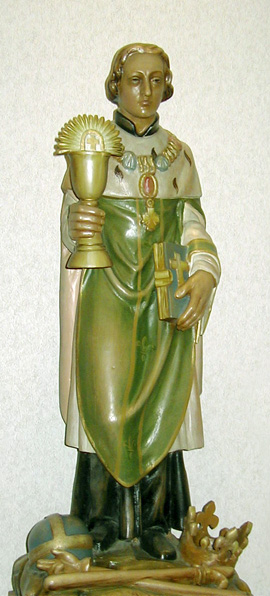
Clodoald, better known as Saint Cloud, was a Merovingian prince, grandson of Clovis I and son of Chlodomer, who preferred to renounce royalty and became a hermit and monk. Clodoald found a hill along the Seine, two leagues below Paris, in a place called Novigentum. Here among the fishermen and farmers, he led a life of solitude and prayer, and built a church, which he dedicated in honor of Martin of Tours.
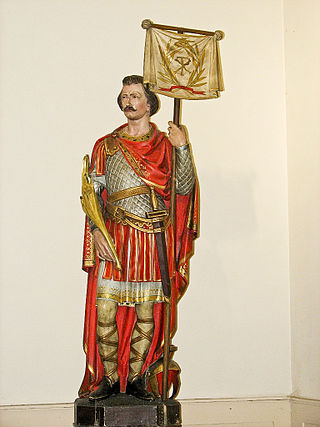
Saint Julian of Brioude (†304) was a legendary martyr and saint from the Auvergne region of France. Although the main focus of his cultus was in the small village of Brioude, he was originally from the city of Vienne, and also associated with Clermont. He was most famous through his association with an aristocratic family of bishops of the time, his most notable proponents being St. Gallus of Clermont and St. Gregory of Tours. Gregory wrote a vita of Julian, but his attempts to expand the saint's cult from the Auvergne to Touraine and Aquitaine were unsuccessful, and Julian is now only remembered through his basilica in the town of Brioude itself.
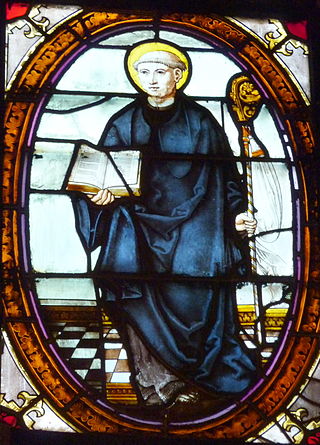
Saint Mederic or Medericus, also known in French as Saint Merri or Médéric, was a monk and a hermit, who is considered patron saint of the right bank of the river Seine in central Paris.
Hanānā or khnana is dust collected from the burial site of a Christian saint or martyr for veneration or consumption. In the East Syriac Rite liturgies of Nestorian Christianity and successor denominations such as the Assyrian Church of the East, hanānā is used in both the anointing of the sick and Mystery of Crowning. Among Assyrian, Ethiopian, and early Latin Christians, the dust of holy persons was associated with healing powers.